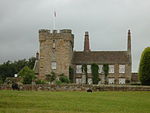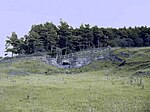Halton, Northumberland
Former civil parishes in NorthumberlandNorthumberland geography stubsUse British English from August 2019Villages in Northumberland

Halton is a village and former civil parish, now in the parish of Whittington, in the southern part of Northumberland, England. It is situated 3 miles (4.8 km) north of Corbridge just south of Hadrian's Wall. In 1951 the parish had a population of 24.Halton Castle is a pele tower and grade I listed building.
Excerpt from the Wikipedia article Halton, Northumberland (License: CC BY-SA 3.0, Authors, Images).Halton, Northumberland
Geographical coordinates (GPS) Address Nearby Places Show on map
Geographical coordinates (GPS)
| Latitude | Longitude |
|---|---|
| N 55.004 ° | E -2.004 ° |
Address
NE45 5PH , Whittington
England, United Kingdom
Open on Google Maps









